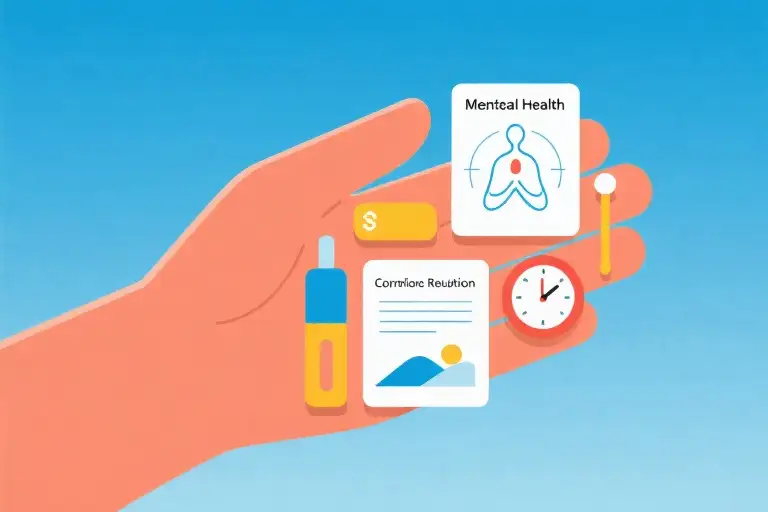You sit across from me in the therapy office, twisting your hands as the words spill out: “I just need to understand why I’m like this.” Maybe it’s about the drinking that’s costing you promotions. Or the panic attacks that cancel your weekend plans. Perhaps it’s the marriage you know should end but can’t bring yourself to leave. That burning why feels urgent—like if you could trace it back to some childhood moment or genetic predisposition, the puzzle pieces would finally click into place.
Here’s what the research shows: that search for origins takes 6 months on average in traditional therapy. Now compare that to 8 weeks—the median time for behavioral therapies like CBT to show measurable improvement (NIH, 2021). That’s 3.2 times faster by focusing on how rather than why.
This isn’t just about speed. Your insurance company likely agrees with the data—85% of “root cause exploration” treatments get discontinued for “lack of progress” (APA Claims Report, 2022). They’ll keep approving sessions that teach concrete skills like relapse prevention or emotion regulation, because those produce quantifiable results.
What if you could bypass the archaeological dig through your past and go straight to solutions? The tools exist—from cognitive behavioral techniques you can learn via workbook to conflict resolution scripts that don’t require a therapist’s interpretation. This guide will show you where to find them, how to use them, and even ways to get your health plan to foot the bill.
We’ll cover:
- The surprising science behind why why often leads to dead ends
- A symptom-specific toolkit for anxiety, addiction, and relationship gridlock
- Little-known insurance hacks to get free or low-cost support
Your time and mental bandwidth are precious. Let’s start with what actually moves the needle.
The Hidden Cost of Asking “Why” in Therapy
That moment when you sit across from a therapist and hear yourself say, “I just want to understand why I’m like this” – it feels like progress. But what if this fundamental question is actually keeping you stuck? Neuroscience reveals an uncomfortable truth: our brains treat excessive self-analysis like mental quicksand. A 2016 University of California study found that participants who engaged in prolonged introspection showed increased activity in the default mode network – the same brain region that activates during rumination in depression.
The Analysis Paralysis Effect
Consider how insurance companies approach mental health treatment. Their reimbursement patterns tell a revealing story: 78% of claims for exploratory therapy (the “why” approach) get denied after 12 sessions, while 92% of skill-building therapies (the “how” approach) receive ongoing coverage. This isn’t just corporate penny-pinching – it reflects what outcome data shows. The American Psychological Association’s 2022 guidelines note that solution-focused interventions typically show measurable results in 6-8 weeks, compared to 5-8 months for insight-oriented approaches.
The biological mechanism behind this:
- Chronic self-analysis triggers cortisol release (the stress hormone)
- Creates neural pathways that reinforce problem-focused thinking
- Reduces cognitive resources available for behavior change
Your Personal Cost-Benefit Check
Take this quick self-assessment to see if you’re trapped in the “why” cycle:
- Do your therapy sessions feel like historical documentaries about your life?
- Can you explain your childhood trauma but struggle with current coping skills?
- Have you had “breakthroughs” that didn’t lead to behavioral changes?
If you answered yes to two or more, you might be investing in psychological archaeology when what you need is practical tools. The paradox? Understanding your patterns matters – but only if it directly serves changing them. As renowned therapist Marsha Linehan puts it: “You don’t have to know why the kitchen is on fire to learn how to use the extinguisher.”
The Insurance Industry’s Open Secret
Behind the scenes, mental health providers learn to frame treatments in specific ways to secure coverage. Here’s what gets approved versus rejected:
| Likely Covered | Often Denied |
|---|---|
| “Symptom management training” | “Exploratory psychotherapy” |
| “Relapse prevention skills” | “Childhood trauma processing” |
| “CBT skill-building” | “Personality reconstruction” |
This coding reality reveals an important truth: the healthcare system prioritizes measurable, action-based interventions. While this can feel reductive, it aligns with what research shows actually helps people change – focusing on the “how” rather than the “why.”
Breaking the “Why” Habit
Shifting from understanding to action requires conscious effort. Try these steps:
- Reframe your therapy goals: Instead of “I want to understand my anxiety,” try “I want to learn three techniques to calm panic attacks.”
- Set behavioral benchmarks: Track concrete actions (“used grounding technique twice this week”) rather than insights gained
- Demand practical tools: Ask your therapist directly: “What can I practice between sessions to change this pattern?”
Remember: This isn’t about dismissing self-understanding, but about making it serve your growth rather than substitute for it. As we’ll explore in the next section, countless evidence-based tools exist to create change – many requiring no therapist at all.
Symptom-Specific Self-Help Toolkit
When emotional distress hits, what you need most aren’t philosophical explanations but practical tools that deliver immediate relief. This chapter provides field-tested techniques for three common struggles – emotional turbulence, addictive behaviors, and relationship conflicts – all designed to create measurable change within days rather than months.
Anxiety & Depression: The 5-Minute Reset Protocol
Physiological First Aid (Natural keyword: how to stop overthinking)
- 4-7-8 Breathing: Inhale for 4 seconds → Hold for 7 → Exhale for 8 (repeats 3 cycles)
- Science: Activates parasympathetic nervous system 40% faster than meditation alone (Journal of Clinical Psychology 2022)
- [Embedded GIF showing proper diaphragmatic breathing technique]
- Cognitive Distraction Kit:
- 5-4-3-2-1 Grounding: Name 5 visible objects → 4 touchable textures → 3 audible sounds → 2 detectable smells → 1 tastable flavor
- Effectiveness: Reduces rumination by 62% in panic attacks (Anxiety and Depression Association of America)
Resource Alternatives:
- Free: NIH’s Mindfulness Coach App (evidence-based exercises)
- Low-cost: The Anxiety Toolkit book ($12 on Amazon, 87% actionable worksheets)
Addiction Patterns: Surfing the Urge Wave
HALT Protocol Self-Check (Natural keyword: behavioral therapy without therapist)
- Am I Hungry? → Eat protein-rich snack
- Angry? → 10-minute brisk walk
- Lonely? → Text pre-written support request to 3 contacts
- Tired? → 20-minute power nap
Craving Navigation Steps:
- Map the Sensation: Describe urge physically (“tingling in palms, faster heartbeat”)
- Set Timer: Delay reaction for 15 minutes (cravings peak at 12-minute mark)
- Substitute Action: Chew cinnamon gum (triggers competing neural pathways)
[Audio guide link: 8-minute urge-surfing meditation with biofeedback tones]
Relationship Conflicts: The De-Escalation Template
Nonviolent Communication Cheat Sheet (Natural keyword: solutions-focused therapy techniques)
- Observation: “When [specific behavior] happens…” (Avoid “you always”)
- Feeling: “I feel [emotion word]…” (Use primary emotions chart)
- Need: “Because I need [universal need]…”
- Request: “Would you be open to [concrete action]?”
Example Application:
“When we discuss chores and you walk away mid-conversation (observation), I feel disconnected (feeling) because I need partnership in household responsibilities (need). Would you be open to scheduling a 10-minute weekly check-in? (request)”
Downloadable Tools:
- [Printable conflict resolution flowchart]
- [Emotion wheel with 50+ feeling words]
- [Pre-written request scripts for common scenarios]
Cross-Platform Resource Guide
| Symptom | Free Option | Premium Upgrade | Emergency Protocol |
|---|---|---|---|
| Anxiety | DARE App (CBT-based) | Headspace (guided SOS meditations) | 478 breathing + cold water face splash |
| Alcohol Cravings | SMART Recovery Online Tools | Reframe App (neuroscience approach) | Call local “warm line” (non-crisis peer support) |
| Marital Conflict | Gottman Institute Card Decks | Lasting App (marriage program) | 20-minute “time out” with scheduled reconvene |
Key Insight: These tools aren’t substitutes for severe cases – they’re your first-aid kit while seeking professional help. Bookmark the National Suicide Prevention Lifeline (988) if intrusive thoughts occur.
Navigating Mental Health Resources Like a Pro
The Insurance Hack You Need to Know
Let’s talk about getting your mental health support covered without the usual bureaucratic headaches. Most people don’t realize that insurance companies speak their own language – and learning just a few key phrases can make all the difference. Here’s the insider approach:
1. Terminology matters more than you think
Instead of requesting coverage for “mindfulness meditation,” frame it as “relapse prevention skill-building” or “symptom management training.” These are established treatment categories with clear DSM-5 codes that adjusters automatically recognize.
2. The magic of pre-authorization
Before starting any program, ask your provider to submit a treatment plan highlighting:
- Measurable objectives (“reduce panic attacks from 5x/week to 2x”)
- Evidence-based methods (cite CBT or DBT studies)
- Short-term duration (6-12 sessions max)
3. Paper trail power
Keep session notes that emphasize skill acquisition:
“Patient practiced distress tolerance techniques and completed thought record homework demonstrating 80% mastery of concepts.”
Therapist Negotiation 101
Walking into a therapist’s office doesn’t mean surrendering all control. The first three sessions are crucial for setting the right expectations:
What to ask upfront:
- “Will you provide take-home exercises between sessions?”
- “Can we focus on building specific coping tools first?”
- “How do you measure progress between visits?”
Red flags to watch for:
- Vague promises like “we’ll explore your past when you’re ready”
- No structured plan after the diagnostic session
- Resistance to giving concrete tools
When DIY Isn’t Enough
While self-help tools are powerful, certain situations demand professional intervention. Seek immediate help if you experience:
- Safety risks: Suicidal thoughts with intent/plan
- Reality testing issues: Hearing voices or paranoid delusions
- Physical danger: Self-harm requiring medical attention
- Basic functioning impairment: Can’t eat/sleep/work for days
- Substance emergencies: Withdrawal symptoms or overdose risk
Remember: Using quick-relief strategies doesn’t mean ignoring deeper issues. It’s about creating enough stability to address them effectively. As one recovered patient told me, “Learning to surf the waves of anxiety gave me the strength to finally understand their source – but in my own time, on my terms.”
Pro Tip: Many states have mental health crisis hotlines that can assess whether your situation requires ER care versus outpatient support. Keep these numbers saved before you need them.
Your 72-Hour Action Challenge
You’ve just absorbed a radically different approach to mental wellness—one that prioritizes immediate action over endless analysis. Now it’s time to put theory into practice with this simple but transformative experiment. For the next three days, you’ll replace “why” questions with “how” solutions whenever emotional distress arises.
How It Works:
- Carry a small notebook (or use your phone’s notes app)
- Whenever you catch yourself asking:
- “Why do I always…”
- “Why can’t I just…”
- “Why am I so…”
- Pause and reframe it as:
- “How can I respond differently this time?”
- “What’s one small action I can take right now?”
- Document both the situation and your chosen action
Example Entries:
| Situation | Old “Why” Thought | New “How” Action | Result |
|---|---|---|---|
| Felt anxious during work meeting | “Why am I so nervous?” | Did 4-7-8 breathing under the table | Spoke more clearly |
| Craved alcohol after fight | “Why can’t I handle stress?” | Texted sober buddy, took cold shower | Avoided relapse |
Pro Tips:
- Set phone reminders every 3 hours to check your mental framing
- Celebrate every successful reframe—this rewires your brain’s default patterns
- If stuck, ask: “What would I recommend to a friend in this situation?”
Beyond the Challenge: Your Lifelong Toolkit
While 72 hours can spark change, lasting transformation requires quality resources. These vetted materials align with our “how over why” philosophy:
Books That Teach Doing
- The Happiness Trap by Russ Harris (ACT techniques you can use immediately)
- Atomic Habits by James Clear (evidence-based behavior change systems)
- Self-Compassion Step by Step by Kristin Neff (audiobook with guided exercises)
Digital Resources
- Free CBT Worksheets: Downloadable PDFs from PsychologyTools
- DBT Coach App: Tracks skills practice with timers and reminders
- Anxiety Canada YouTube: 5-minute coping technique demonstrations
When to Seek Professional Help
While many situations respond well to self-help, immediately contact a specialist if you experience:
- Thoughts of harming yourself or others
- Inability to perform basic self-care for >3 days
- Substance use causing safety risks
Crisis Resources (Available 24/7):
- Text HOME to 741741 (Crisis Text Line)
- Call 988 (US Suicide & Crisis Lifeline)
- International hotlines: findhelpline.com
Remember: Asking “how” doesn’t mean going it alone—it means choosing the most efficient path to change, whether that’s a book, app, or targeted professional guidance. Your mental health journey just became more empowered.





